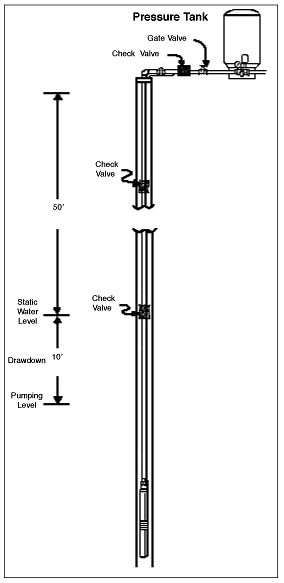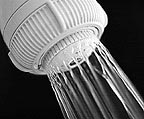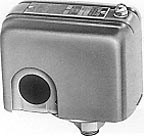There are three factors that go into determining the pressure required from a pump in a residential water system.
1) Lift Pressure - pressure required to get the water from down in the well to the pressure tank
2) Household Pressure - pressure required in the house to properly feed the fixtures
3) Friction Loss - pressure required to overcome the friction in the pipes and fittings
This month we will examine the first two factors and tackle friction loss next time.

Lift Pressure
The first factor to consider is the pressure required to lift the water from the well to the pressure tank. The total lift required is the distance from the top of the water at the pumping level in the well to the highest fixture in the system, typically a second-story showerhead. We’ll let the pressure tank and pressure switch take care of the in-home lifting/pressure part as will be explained in a few moments. For now, let’s only consider getting water from the well to the pressure tank.The pumping level in the well is the level that the water drops to after the pump has been running long enough for the water level to stabilize. When the pump has been off long enough for the water level to rise to its natural height, this level is called the standing water level or the static level.
The difference between static level and pumping level can be as little as a few inches in an under-utilized high-yield well to several hundred feet in a slow-producing well. The amount of lifting work the pump has to do is determined by the pumping level, not the static level or position of the pump in the well. The pumping level can change from season to season and year to year, depending on ground water availability. Make sure you size your system to take into account the lowest probable pumping level.

Household Pressure
It is important to provide enough water pressure at the fixtures in the home to satisfy the comfort needs of the family. The Uniform Plumbing Code requires a minimum of 15 psi at each fixture. The easiest way to deal with the household pressure component of the total system pressure requirements is to choose a pressure tank operating range which will provide at least 15 psi at the highest fixture. More on this in a moment.
Lift pressure is measured in terms of “feet of head”, i.e., the pumping level is 60 feet below the pressure tank. The household pressure is measured in terms of PSI (pounds per square inch), i.e., the pressure tank operates through a range of 30 psi to 50 psi. Just remember, you can use either term to express pressure, but you must be consistent in your formulas. And remember you can convert from one to the other by using the factors — 1 psi = 2.3 feet of head or conversely 1 foot of head = .433 psi.

Considering the
Pressure Switch
The function of a pressure switch is to turn on the pump when the system pressure drops to the minimum set point and to turn it off when the system pressure reaches the maximum set point. The most commonly used pressure switches have a 20-psi spread between the turn on point and the turn off point, and they are available in a number of on/off presets — 20/40, 30/50, 40/60, etc. With a 20/40-pressure switch, the pump will be turned on when the pressure drops to 20 psi and turned off at 40 psi. With a 30/50-pressure switch, the pump will be turned on when the pressure drops to 30 psi and off at 50 psi, and so on.It is the pressure switch turn-on pressure (30 psi for a 30/50 switch) that determines the minimum system pressure at the highest fixture in the house. And it is the pressure switch turn-off pressure (50 psi) that is the household pressure portion of your system pressure calculation. Let’s say you have a 30/50-pressure switch. That means the minimum system pressure at the tank will be 30 psi. From the conversion formula above, for each foot in elevation above the tank, you loose .433 pounds. If you have a single-story house and the pressure tank is in the garage, 3 feet below the living level, that 7-foot high showerhead in the bathroom will be 10 feet above the pressure tank. Therefore, the pressure at this point will be 4.33 psi less than the pressure at the tank (10 feet X .433). The minimum system pressure at the showerhead will be 25.7 psi (30 – 4.33 = 25.7), assuming no friction loss in the pipes.
If you have a two-story house with a basement, that showerhead could be 25 feet above the pressure tank. In this case, the available pressure at the shower would be 30 – (25 x .433) = 19.2 psi, sufficient to meet the minimum of 15 psi requirement.
Calculating
Total Pressure
In our example, the static water level in the well is at 50 feet below the pressure tank, and the well draws down 10 feet, making the pumping level 60 feet. The household pressure requirement would be 50 psi because you are using a 30/50-pressure switch, which meets the minimum allowable pressure of 15 psi in the second-story showerhead. The total pressure required without friction loss, in terms of feet of head, would be
Lift pressure 60 ft.
Household pressure + 50 psi
x 2.31 = 116 ft.
Total 176 ft.
Converting from feet of head back to PSI, you get 176 ft. x .433 = 76 psi. (Mathematically speaking, it doesn’t matter which terms you use; just be consistent. You cannot add feet of head to PSI in an equation. All factors in the equation must be in the same terms. Once you’ve finished your math, you can convert back and forth.)
Next month, we will continue this series on pump sizing with a look at pressure loss in the pipes. ’Til then ... .


Report Abusive Comment